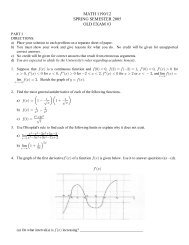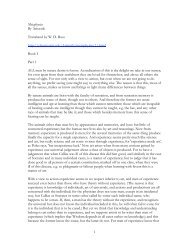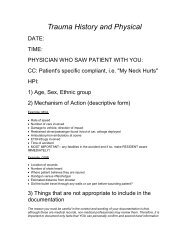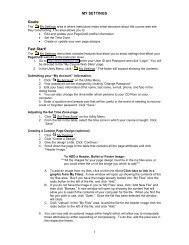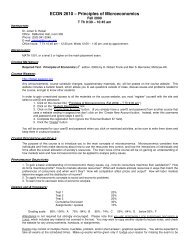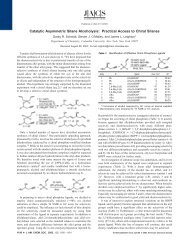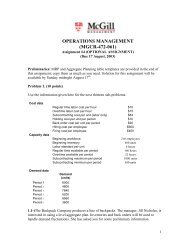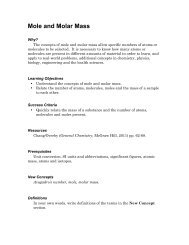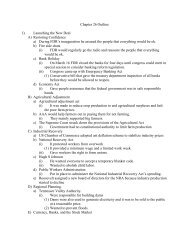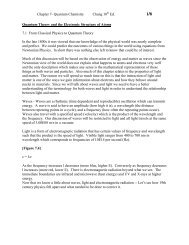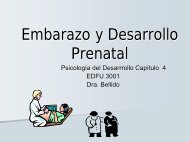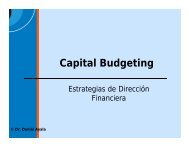THE BUNSEN BURNER AND LABORATORY ... - PageOut
THE BUNSEN BURNER AND LABORATORY ... - PageOut
THE BUNSEN BURNER AND LABORATORY ... - PageOut
Create successful ePaper yourself
Turn your PDF publications into a flip-book with our unique Google optimized e-Paper software.
<strong>THE</strong> <strong>BUNSEN</strong> <strong>BURNER</strong> <strong>AND</strong><br />
<strong>LABORATORY</strong> MEASUREMENT<br />
Supplemental Experiment<br />
1<br />
Bunsen Burner<br />
• Source of heat<br />
• Natural Gas - Methane<br />
• CH 4 + 2O 2 → CO 2 + 2H 2 O<br />
• 2CH 4 + 3O 2 → 2 CO + 4H 2 O<br />
• CH 4 + O 2 → C + 2H 2 O<br />
NCC Chemistry Dept. 2<br />
© D.S. Cody<br />
Parts of Bunsen Burner<br />
• Gas inlet<br />
• Nozzle<br />
• Air vents<br />
• Needle valve<br />
• Barrel<br />
• Hose<br />
NCC Chemistry Dept. 3<br />
© D.S. Cody
Lighting a Bunsen Burner<br />
• Check connections to burner and desk<br />
outlet valve.<br />
• Close needle valve and barrel.<br />
• Open desk outlet valve fully.<br />
• Check for leaks with flame.<br />
• While holding flame above barrel, open<br />
needle valve 1/2 turn.<br />
• Adjust barrel and needle valve for blue<br />
in blue flame.<br />
NCC Chemistry Dept. 4<br />
© D.S. Cody<br />
Bunsen Burner Safety<br />
• Long hair should be tied back out of the way<br />
• Loose clothing, cuffs, shirttails should be secured so that they do<br />
not accidentally dangle in the flame.<br />
• Always light the burner in open space on lab counter.<br />
• After you have adjusted it for the flame needed move it into<br />
position.<br />
• Know where the hot parts of the burner are when it is lit; the<br />
needle valve and air vent jacket are cool enough to be touched<br />
and adjusted while the burner is ignited.<br />
• Know where the safety equipment is, including the fire blanket,<br />
the gas main shut-off, and the fire extinguisher.<br />
• NEVER leave a lit Bunsen burner unattended!<br />
• Always hold and carry a Bunsen burner by the base; the barrel<br />
might still be hot!<br />
NCC Chemistry Dept. 5<br />
© D.S. Cody<br />
Times of Burner Flames<br />
• Safety flame<br />
Pale Blue<br />
• coolest<br />
Flame<br />
• yellow/orange color<br />
Hottest Part of<br />
• burns at approximately 300°C<br />
Flame<br />
• Blue flame<br />
Bright<br />
• medium flame<br />
Blue<br />
Inner<br />
Core<br />
• burns at approximately 500°C<br />
• “Roaring” Blue flame<br />
• hottest flame<br />
• reaching temperatures as high as 800°C inner blue<br />
cone = hottest part of the flame<br />
NCC Chemistry Dept. 6<br />
© D.S. Cody
Accuracy & Precision<br />
• Accuracy indicates<br />
how close a<br />
measurement is to<br />
More Precise<br />
Less Precise<br />
the accepted value.<br />
Trial #1 Mass (g)<br />
1<br />
100.00<br />
Trial #2 Mass (g)<br />
1 100.10<br />
2<br />
100.01 2 100.00<br />
• Precision indicates<br />
3<br />
99.99 3<br />
99.88<br />
how close together 4<br />
99.99 4 100.02<br />
Average 100.00 Average 100.00<br />
or how repeatable<br />
Range<br />
±0.01 Range<br />
±0.11<br />
the results are. Std. Dev. 0.05 Std. Dev. 0.09<br />
NCC Chemistry Dept. 7<br />
© D.S. Cody<br />
NCC Chemistry Dept. 8<br />
© D.S. Cody<br />
Significant Digits/Figures<br />
• Significant digits<br />
• all the numbers that are certain<br />
• one digit that contains some uncertainty<br />
• Always write numbers in scientific<br />
notation if there is any confusion about<br />
the number of significant digits they<br />
contain.<br />
NCC Chemistry Dept. 9<br />
© D.S. Cody
Significant Digits/Figures<br />
• The line is longer than 9 cm, but not quite 10<br />
• The line is > 9.5 and < 9.7 cm long<br />
• The line is 9.60 cm<br />
• We record all the numbers of which we are<br />
certain (the 9.6) and the first digit we are not<br />
sure of (the 0.00)<br />
NCC Chemistry Dept. 10<br />
© D.S. Cody<br />
Percent Error<br />
• A measure of how well the experiment is<br />
done.<br />
( experimental value−accepted value)<br />
Percent Error =<br />
× 100<br />
acceptedvalue<br />
NCC Chemistry Dept. 11<br />
© D.S. Cody<br />
Bunsen Burner<br />
• Sketch the Bunsen burner<br />
• Label the gas inlet nozzle, air vents, needle<br />
valve, barrel, hose & desk outlet valve.<br />
• Briefly, note the function of each.<br />
• Operate burner<br />
• Luminous flame<br />
• Non-luminous flame<br />
• Air-vent operation and deposition<br />
NCC Chemistry Dept. 12<br />
© D.S. Cody
Measurement<br />
• Length<br />
• Laboratory Report<br />
• Dollar Bill<br />
• Cm/in ratios<br />
• Percent Difference<br />
• Mass<br />
• 2 Different Coins<br />
• Volume<br />
• 50 mL Beaker & 50 ml Graduated Cylinder<br />
• Volume (mL) conversion to (oz)<br />
NCC Chemistry Dept. 13<br />
© D.S. Cody<br />
Chemical Conversions<br />
• Practice using<br />
conversion<br />
factors<br />
• Practice using<br />
Dimensional<br />
Analysis<br />
• Show all work<br />
NCC Chemistry Dept. 14<br />
© D.S. Cody<br />
Cleanup & Waste Disposal<br />
• General Cleanup<br />
• No Hazardous<br />
Waste Produced<br />
NCC Chemistry Dept. 15<br />
© D.S. Cody




